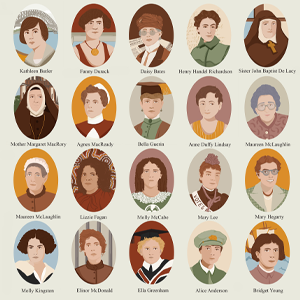St Brigid’s Day Festival celebrates Irish-Australian women
Published in Issue 2 (March/April 2020), News, Volume 28The Australian Irish community in Sydney celebrated the St Brigid’s Day Festival this year with readings, music performances and poetry on the saint’s day (1 February), followed the next day by an all-day seminar showcasing the historical and cultural contribution of Irish-Australian women in shaping modern Australia.
By Jeff Kildea

The Aisling 20/20 Vision seminar was held at the State Library of New South Wales under the auspices of the Consulate-General of Ireland and the Aisling Society of Sydney, an Irish-Australian cultural organisation founded in 1955 (http://aislingsociety.org.au). During the day, speakers narrated the lives and achievements of twenty women, either Irish-born or of Irish heritage.
Some names are reasonably well known, such as Daisy Bates from County Tipperary, a journalist and anthropologist who in the early twentieth century gained international fame as a welfare worker among Australian Aborigines. Another is Sarah ‘Fanny’ Durack, the winner of the first gold medal in women’s Olympic swimming. Born in Sydney to Irish parents, her performance at the 1912 Stockholm Olympics was hailed in the Irish Times. At those Olympics Durack broke the world record for the 100-metre freestyle wearing a close-fitting swimming costume rather than the thick, modest, woollen swimsuit considered appropriate for women. Over the next six years she broke twelve world records.
One of the celebrated women whose name might be familiar to Irish readers was Mary Dwyer, who, along with her husband Michael Dwyer (‘the Wicklow Chief’), continued to fight on in the Wicklow Mountains after the 1798 Rebellion. She and Michael were exiled to New South Wales in 1806. They are buried beneath the 1798 Memorial in Sydney’s Waverley Cemetery. Some might also have heard of Henry Handel Richardson, the internationally renowned author of The getting of wisdom (1910) and The fortunes of Richard Mahoney (1930). Like many female novelists, Melbourne-born Ethel Florence Richardson, daughter of Irish parents, adopted a male pseudonym.
The seminar’s greatest achievement, however, was to highlight the quiet achievers whose names are unfamiliar to the Australian public, let alone overseas. One is Agnes Macready of County Down, who emigrated to Australia in 1880, aged twelve. She became Australia’s first female war correspondent. After volunteering as a nurse in the Boer War, Macready was commissioned by Sydney’s Irish-Catholic newspaper, the Catholic Press, to send back reports on the war. Although she was not permitted to visit the front, her reports had a certain power that came from the unique perspective from which she wrote—as a nurse and ‘with a woman’s eyes’. According to the newspaper, her ‘beautiful and pathetic’ articles were ‘acknowledged to be among the best war correspondence published here or in the old world’. During the First World War Macready continued writing for the Catholic Press, contributing articles addressed to women in which she opposed militarism and what she called ‘the vivid scarlet sin of conscription’.
Another relative unknown is Bella Guerin, the first woman to graduate from an Australian university, having been awarded a Bachelor of Arts degree by Melbourne University in December 1883—an impressive achievement made all the more remarkable by the fact that she was educated at home by her Irish-born mother. Guerin became an advocate of women’s suffrage and various radical causes, with her speeches reported in publications such as Labor Call and The Socialist. She described her political evolution as a transformation from ‘imperialistic butterfly’ to ‘democratic grub’. During the First World War Guerin actively opposed conscription. After the war she continued moving to the left, lecturing at socialist meetings and on Melbourne’s Yarra Bank, where she was arrested for flying the red flag.
Another advocate of women’s rights was Mary Lee from County Monaghan, who emigrated to Adelaide in 1879, aged 58. She agitated for change through letters to newspapers, speaking engagements and community and trade union organisations. Lee was a driving force behind achieving women’s suffrage in South Australia in 1895, a world first.
Also among the seminar’s subjects were two Irish-born nuns: Sister John Baptist de Lacy, who worked with female convicts, orphans and the poor in mid-nineteenth-century Sydney, and Mother Margaret MacRory, who later in the century and in the next devoted her life to the education of girls and young women.
Perhaps the most colourful story was that of Alice Anderson, the daughter of Irish immigrants who became an industrial-inventor and mechanical engineer. Her claim to fame was that in 1919 she established ‘Kew Garage’, the first Australian all-woman garage workshop in Victoria. An avid adventurer, Anderson offered services for local and interstate tourism and conducted great motor-travel feats of her own.
Jeff Kildea is an adjunct professor in Irish Studies at the University of New South Wales and secretary of the Aisling Society of Sydney.
















